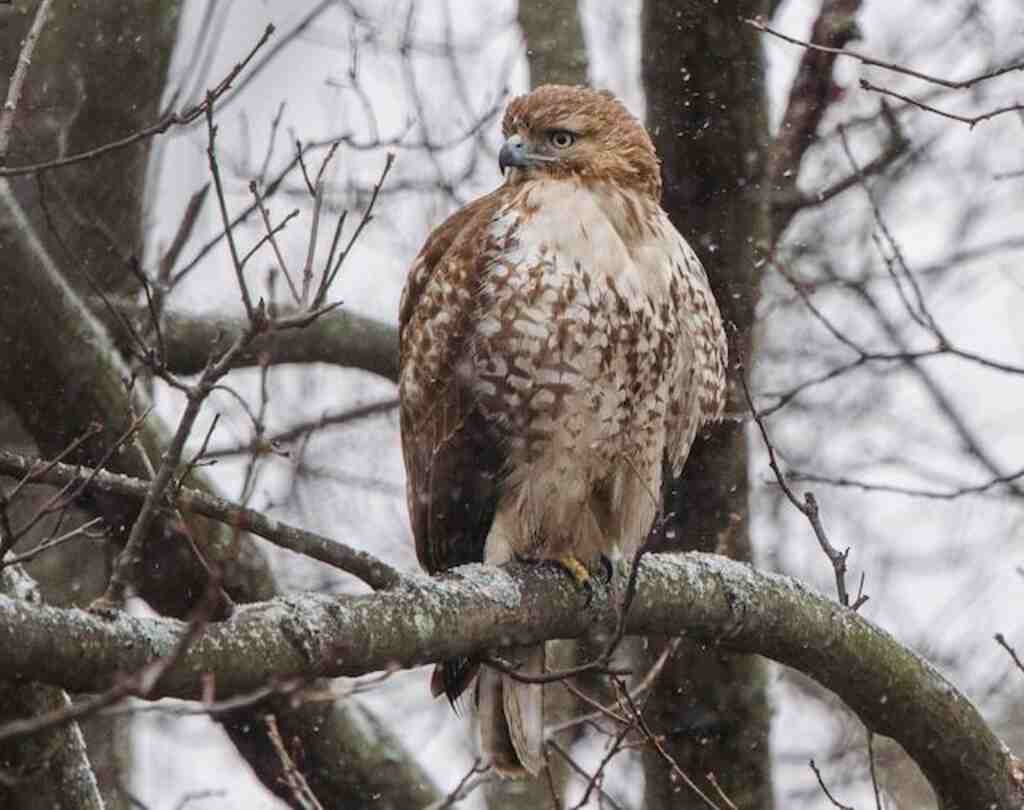As winter sets in, it’s easy for many of us to hunker down and indulge in our favorite comfort foods. But for hawks, the colder months bring a unique set of challenges when it comes to finding sustenance.
While we may be enjoying hearty stews and warm bread, these birds of prey must rely on their instincts and adaptability to survive.
In this article, we will explore the fascinating world of hawk winter diets, from their primary food sources to their hunting techniques and migration patterns.
Despite their reputation as fierce hunters, hawks face a daunting task when it comes to finding food in the winter.
With fewer daylight hours and a decrease in prey availability, these birds must be strategic in their hunting and feeding habits.
However, their ability to adapt to changing circumstances is truly remarkable. What do hawks eat in the winter?
Join us as we take a closer look at the world of these majestic birds and their survival strategies during the coldest months of the year.
Table of Contents
- 1 Key Takeaways
- 2 The Importance of Diet for Hawks in Winter
- 3 Adaptations for Winter Survival
- 4 Primary Food Sources
- 5 What Do Hawks Eat in the Winter
- 6 Hunting Techniques
- 7 Competition for Resources
- 8 Migration Patterns
- 9 Role of Habitat in Winter Diet
- 10 Impact of Climate Change
- 11 Conservation Efforts
- 12 Frequently Asked Questions
- 12.1 How do hawks differ in their winter diet compared to other birds of prey?
- 12.2 What is the impact of human activities on the winter diet of hawks?
- 12.3 Do hawks migrate to different areas in search of food during the winter?
- 12.4 How do hawks adapt to changes in their primary food sources during the winter?
- 12.5 Are there any specific conservation efforts in place to protect the winter diet of hawks?
- 13 Conclusion
- 14 Author
Key Takeaways
- Small mammals like mice, voles, and rabbits are the primary food sources for hawks in the winter.
- Hawks are selective in their prey choices, targeting weaker or slower animals.
- Changes in behavior, physical characteristics, and hunting strategies are adaptations that help hawks survive the winter.
- Human activity and climate change are negatively impacting the availability and distribution of prey species, which may have significant impacts on the winter diet of hawks.
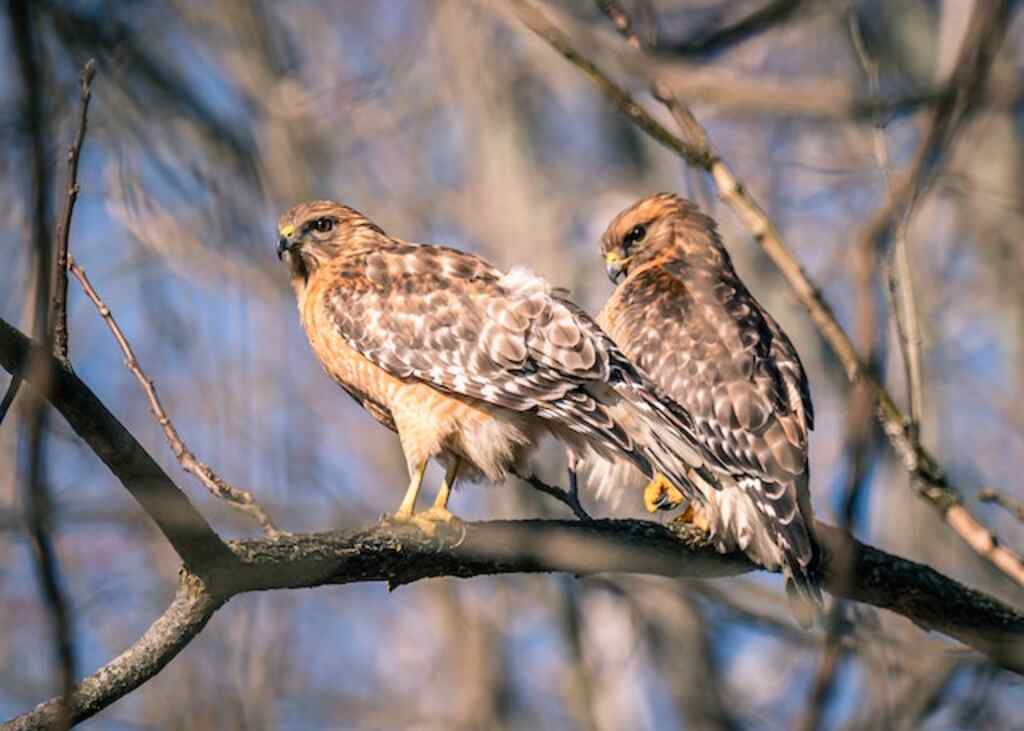
The Importance of Diet for Hawks in Winter
The nutritional requirements of hawks during winter months are crucial for their survival and reproductive success. Hawks need to consume a varied diet in order to maintain their health and energy levels.
The importance of prey diversity cannot be overstated, as it provides hawks with the necessary nutrients they need to survive.
However, human activity has a significant impact on the availability of prey for hawks.
It is important for humans to be aware of the impact they have on the environment and take steps to reduce their negative impact.
With that said, hawks have evolved adaptations to cope with the challenges of winter, such as changes in behavior and physical characteristics.
Adaptations for Winter Survival
Adaptations for surviving the harsh winter conditions include modifications to hunting strategies and adjustments in metabolic rates, which enable birds of prey to conserve energy during periods of scarce food availability.
Hawks have a variety of survival strategies in place to help them endure the winter months.
These strategies include the following adaptations:
- Shifting to different prey: Some hawks will adjust their diet to include more rodents or small mammals during the winter months when their usual prey, such as insects or reptiles, are not available.
- Reducing metabolic rates: Hawks will also lower their metabolic rates to conserve energy during times of food scarcity, which allows them to survive for longer periods without eating.
- Selecting optimal perches: To avoid expending energy flying, hawks will choose perches that are in the sun, sheltered from the wind, and close to potential prey.
- Using communal roosts: Some hawks will also form communal roosts during the winter months, which allows them to conserve body heat and provides safety in numbers.
These adaptations are crucial for the survival of hawks during the winter months when food is scarce. Understanding the strategies that hawks use to survive during the winter can help us appreciate the incredible adaptations that these birds have developed to survive in harsh conditions.
In the next section, we will explore the primary food sources that hawks rely on to survive during the winter months.
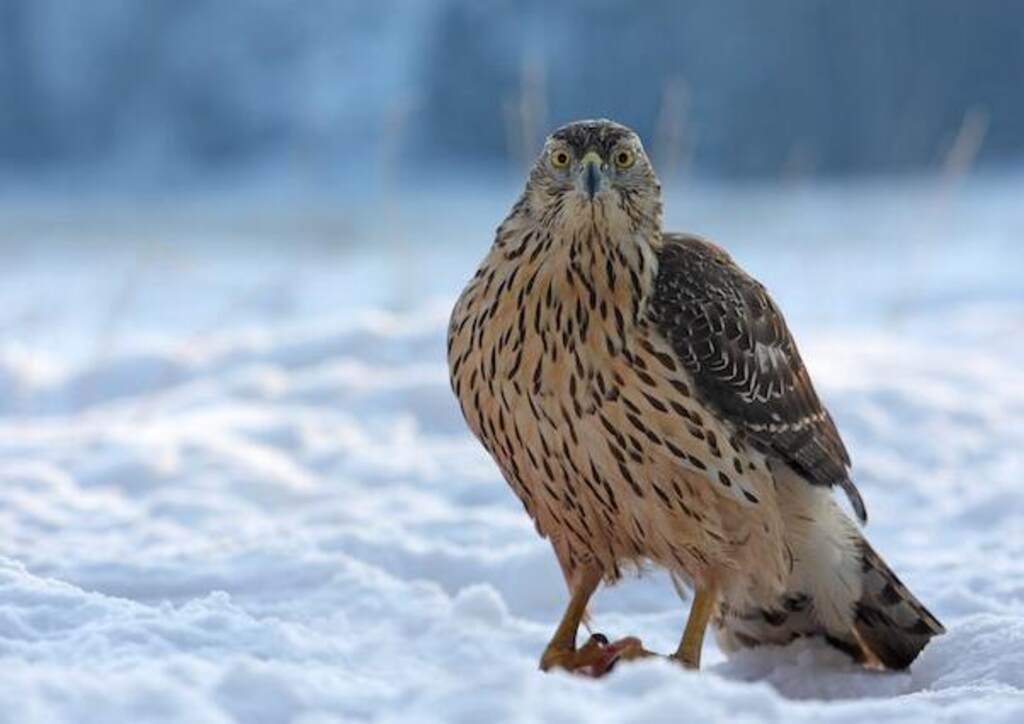
Primary Food Sources
The primary food sources for hawks include small mammals such as mice, voles, and rabbits. These are essential for hawks during the winter months when other food sources become scarce.
Additionally, hawks also feed on birds and snakes, and insects are also an important food source for some species of hawks.
The availability of these primary food sources can greatly impact the survival and reproductive success of hawks in their environment.
Small mammals like mice, voles, and rabbits
Small mammals such as mice, voles, and rabbits serve as a crucial food source for hawks during the winter months. Winter diet diversification is essential for hawks, as prey population fluctuations occur during this time.
Hawks need to adapt to the changing environment by shifting their diets to accommodate for the scarcity of their usual prey.
These small mammals make up a significant portion of the hawk’s diet, providing them with the necessary nutrients to survive during the harsh winter months.
Hawks have excellent vision, which they use to locate their prey from high above, and then fly down to capture them with their sharp talons.
The ability to prey on small mammals provides hawks with a steady and diverse food source during the winter, which allows them to survive until the warmer months.
In addition, hawks also feed on other animals such as birds and snakes, which we will explore in the subsequent section.
Birds and snakes
Birds and snakes are also part of the diverse diet of hawks during the winter months, providing them with a range of options to sustain themselves.
The predator-prey dynamics in the ecosystem are evident in the selection of these particular food sources.
Hawks are known to feed on birds such as sparrows, finches, and doves, which are readily available during the winter months.
Snakes, including garter snakes and rattlesnakes, are also fair game for hawks.
However, the ecological balance must be maintained, as hawks themselves are prey for larger predators such as eagles and owls.
The availability of these food sources is crucial to the survival of hawks during the winter months.
As we move to the next subtopic, it is important to note that insects are also part of the diverse diet of hawks, and they play a critical role in the food chain.
Insects
Insects occupy a significant place in the diverse diet of hawks during the winter months, contributing to the complex food chain in the ecosystem.
As predators, hawks interact with various other species in their environment, including insects.
Insects are a crucial source of nutrition for hawks, providing them with the energy needed to survive the harsh winter months.
Some of the most common insects consumed by hawks include grasshoppers, crickets, and beetles.
These insects are not only a valuable food source for hawks, but they also have a significant impact on the ecosystem.
They play a crucial role in pollination and decomposition, and their interactions with predators like hawks help to maintain a balance in the food chain.
Understanding the role of insects in the diet of hawks is essential for understanding the complex interactions that occur in the ecosystem.
In the next section, we will explore the hunting techniques used by hawks to catch their prey.
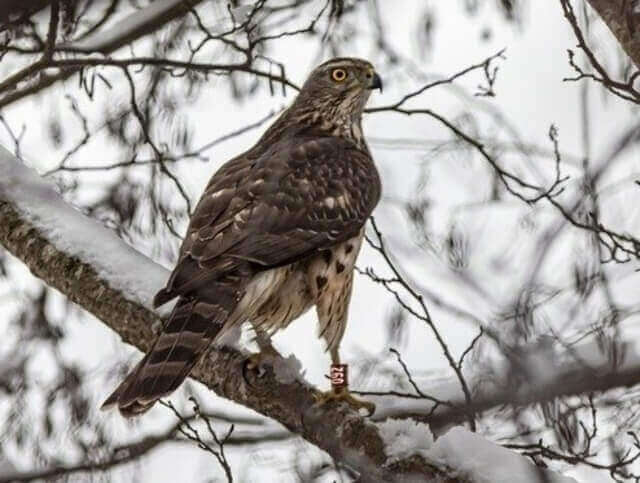
What Do Hawks Eat in the Winter
In winter, hawks primarily feed on small mammals like mice, voles, and rabbits. They also target birds and snakes, as well as insects, when other food sources are scarce.
Their diet varies based on habitat and species. Hawks have adaptations and hunting techniques to catch their prey, such as perching, active hunting, and cooperative hunting.
Changes in food availability and migration patterns due to climate change can impact their winter diet. Conservation efforts aim to protect their food sources and ensure their survival.
Hunting Techniques
The hunting techniques of hawks are diverse and intricate.
One of the most common techniques is perching and waiting. Hawks will perch on a high vantage point and wait for prey to come into view before swooping down to capture it.
Another technique is active hunting, where hawks will fly over an area in search of prey, using their sharp eyesight to spot potential targets.
Additionally, some hawks engage in cooperative hunting, where they work together to capture larger prey.
These techniques allow hawks to efficiently and effectively hunt for their primary food sources.
Perching and waiting
Perched atop a leafless tree, the hawk patiently waits for its prey to scurry beneath the snow-covered ground. This perching behavior is a common hunting strategy of hawks during the winter months.
They rely on their keen eyesight and sharp talons to capture small mammals such as mice, voles, and rabbits.
To convey a deeper meaning for the audience, here are three key points about hawk perching behavior:
1) Hawks choose high perches to survey the surrounding area for prey,
2) They remain motionless for long periods of time, conserving energy while waiting for an opportunity to hunt, and
3) Hawks may adjust their perching location based on the availability of prey.
This hunting strategy allows hawks to maximize their chances of catching prey while minimizing energy expenditure. As the winter wears on and prey becomes scarcer, hawks may switch to more active hunting techniques.
Active hunting
During active hunting, hawks exhibit a range of aerial maneuvers to capture prey, demonstrating their agility and precision in flight. This hunting style is particularly useful during the winter when prey is scarce.
Hawks are known to hunt at night, using their keen eyesight to detect movement on the ground. They will swoop down and capture smaller prey, such as rodents, in their talons, and then carry them off to eat.
In addition to their physical abilities, hawks are also selective in their prey choices, often targeting weaker or slower animals. This helps to ensure their survival during times when food is scarce.
As we move into the next section on cooperative hunting, it is worth noting that while hawks are primarily solitary hunters, they have been known to work together to capture larger prey.
Cooperative hunting
Interestingly, despite their primarily solitary nature, hawks have been observed engaging in cooperative hunting behaviors to secure larger prey.
Cooperative hunting is a tactic employed by some raptor species, particularly Harris’s hawks, to hunt larger prey that would be difficult to capture alone.
In these hunts, one hawk acts as the “driver” and chases the prey while the other hawks act as the “blockers” and wait for the prey to take evasive action, thereby exposing itself to attack.
This tactic allows hawks to select larger prey, such as rabbits, squirrels, and even snakes, which they may not be able to catch on their own.
Prey selection in cooperative hunts is also influenced by the size and strength of the prey, as larger prey require more hawks to successfully capture and subdue.
Overall, cooperative hunting allows hawks to increase their hunting efficiency and secure larger prey, which is important during the winter when food resources are scarce.
As we will see in the next section, competition for these resources can be fierce among hawks and other predators.
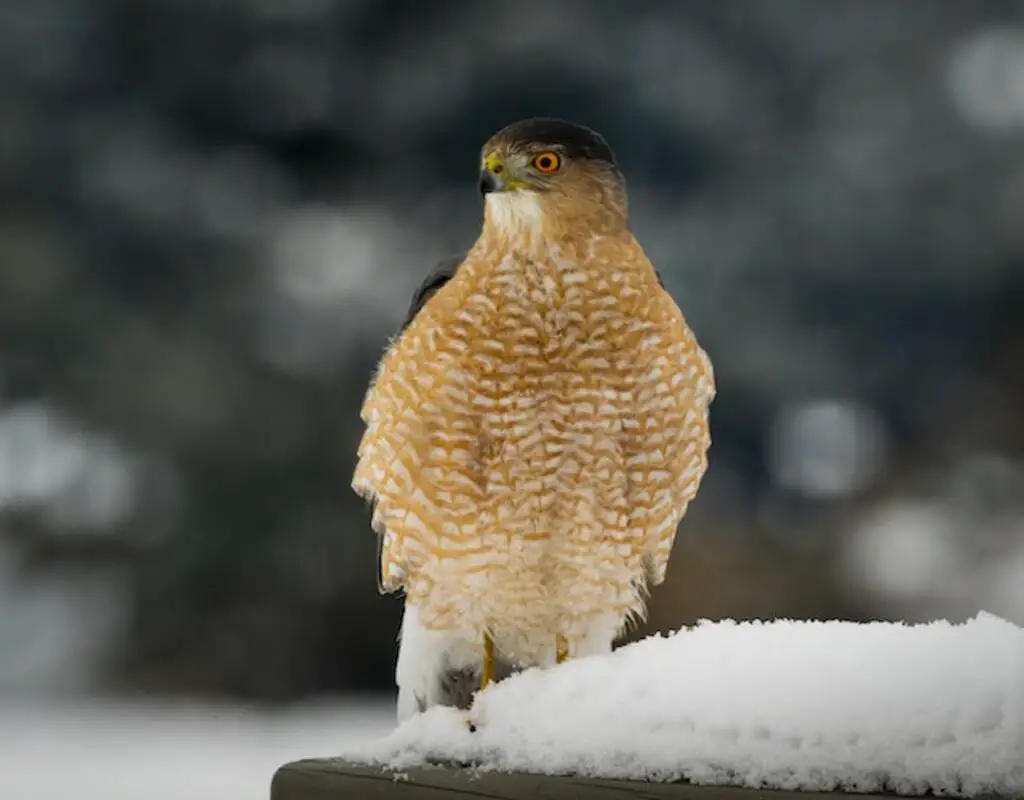
Competition for Resources
Competition for resources during the winter months can be intense among various bird species, including hawks, as they compete for limited food sources.
Resource scarcity is a significant challenge for hawks as they rely on prey, such as rodents, which may be scarce during the winter months.
This scarcity leads to interspecific competition, as hawks struggle to secure a sufficient food supply. In some cases, hawks may resort to scavenging or stealing food from other birds.
This competition can lead to aggression and even fights between hawks and other birds.
Despite these challenges, hawks have adapted to cope with this competition, and their hunting strategies may change depending on the availability of food sources.
As we delve further into the topic of what hawks eat in winter, we will also explore their migration patterns and how they adapt to these harsh conditions.
Migration Patterns
Migration patterns of hawks are an intriguing area of study that sheds light on their adaptive behavior during seasonal changes.
Some species of hawks undertake long-distance migration to escape the harsh winter weather while others stay put in their winter habitats.
These patterns are influenced by various factors such as availability of prey, weather conditions, and breeding requirements.
Understanding the migratory behavior of hawks can provide valuable insights into the ecology and conservation of these magnificent birds of prey.
Hawks that migrate
During winter, hawks that migrate consume approximately 20% more food than those that remain in their resident areas.
Migratory patterns of hawks are closely linked to seasonal changes in food availability, and during winter, many species of hawks fly south in search of more abundant food sources.
This behavior is an essential adaptation that ensures the survival of these birds during the harsh winter months.
To illustrate this, a study of migratory hawks found that they ate more small mammals, such as rodents and rabbits, during the winter months than in the summer months.
This increase in food consumption is necessary for hawks to maintain their energy levels and body weight in preparation for their long migration back to their breeding grounds in the spring.
The table below shows the average daily food intake of migratory hawks during winter and summer months, highlighting the difference in food consumption between these two seasons.
As hawks migrate in search of food during the winter, this behavior reflects their subconscious desire for freedom and the innate drive to survive in harsh and unpredictable environments.
| Food Intake (grams) | Winter | Summer |
|---|---|---|
| Small mammals | 90 | 50 |
| Birds | 40 | 30 |
| Insects | 20 | 15 |
| Reptiles | 10 | 5 |
| Fish | 5 | 0 |
Hawks that stay in winter habitats also face challenges in finding food, but they have adapted to their environment by changing their hunting methods and prey selection.
Hawks that stay in winter habitats
Hawks that remain in their winter habitats have adapted their hunting strategies and prey selection to overcome the challenges of finding food in the harsh winter environment.
Winter hawk behavior can vary depending on the species and the availability of prey.
Some hawks, such as the red-tailed hawk, will stay in their breeding range and hunt small mammals like rodents, rabbits, and squirrels.
Other hawks, such as the rough-legged hawk, will migrate south to areas with higher prey abundance, such as open fields where they can hunt small rodents and birds.
Hawks that remain in their winter habitats may also switch to hunting birds and insects as other prey sources become scarce.
Additionally, they may adjust their hunting techniques, such as hunting during the day when temperatures are warmer and prey is more active.
The role of habitat in winter diet is crucial, as hawks need access to areas with ample food sources and suitable roosting spots.

Role of Habitat in Winter Diet
The availability of suitable habitats greatly influences the winter diet of various raptor species. Hawks that stay in winter habitats are highly dependent on the availability of prey species, which in turn are influenced by the habitat characteristics.
The role of human activity in winter habitats also plays a significant role in determining the availability of prey species.
Human activities such as deforestation, land-use change, and urbanization can negatively impact the ecosystem, leading to a decline in the prey species, and hence, a shift in the diet of hawks.
Additionally, climate change is also expected to have a significant impact on the winter diet of hawks, as it may alter the availability of prey species and their distribution.
As the climate continues to change, it is crucial to monitor the impact on the ecosystem and the subsequent effect on the winter diet of hawks.
Impact of Climate Change
The impact of climate change on the winter diet of hawks is a topic of growing concern for ecologists and ornithologists.
Changing environmental conditions are already affecting the availability and distribution of prey species, leading to changes in the composition of the hawks’ diet.
Additionally, climate change is also influencing migration patterns, with some species of hawks changing their wintering grounds or altering their timing of migration.
These complex interactions highlight the need for further research to understand the implications of climate change on the ecology of raptors.
Changing food sources and availability
Winter is a season of scarcity for many prey species, leading to a dramatic reduction in the availability of food sources for predators such as hawks.
Adapting to scarcity, hawks change their hunting strategies and prey preferences to compensate for the decreased food availability.
However, this adaptation is not always sufficient, and hawks may struggle to find enough food to survive the winter.
Prey population fluctuations also affect hawks’ food sources, as some species may be more abundant in certain years than others.
This unpredictability makes it difficult for hawks to rely on a consistent food source and may lead to increased competition among predators.
Additionally, habitat loss and climate change may alter the distribution and abundance of prey species, further complicating the food web dynamics.
As a result, hawks may need to expand their hunting range or switch to alternative prey items to survive.
These challenges demonstrate the importance of understanding the complex interactions between predators and prey in winter ecosystems.
Understanding these interactions can help inform conservation efforts to ensure the survival of these important predator species.
Changes in migration patterns may also play a role in the availability of food sources for hawks, as they may need to adjust their migration timing to coincide with the peak availability of prey in different regions.
Changes in migration patterns
As food sources and availability change during the winter months, hawks must adapt their hunting strategies to survive.
However, changes in migration patterns caused by the effects of climate change can also impact their ability to find food.
The Hawks have a strong connection to their habitat and rely on it to find their prey. Thus, when their habitats are altered, the availability of food becomes scarce, and the hawks may struggle to survive.
Understanding how habitat influences the hawks’ hunting behavior can inform conservation efforts to protect their food sources and ensure their survival.
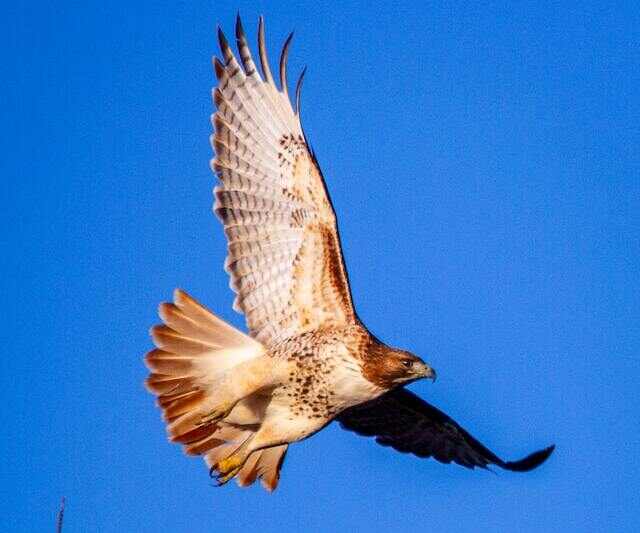
Conservation Efforts
Efforts aimed at the conservation of hawk populations during the winter months have been implemented by various wildlife organizations.
These efforts primarily focus on habitat preservation, as hawks rely on specific environments to hunt and survive.
Organizations work to protect and restore the habitats that hawks need, such as grasslands, wetlands, and forests.
Additionally, some organizations have implemented programs to monitor hawk populations and track their movements during the winter months.
These efforts help to identify areas where hawks may be struggling to find food or shelter, allowing conservationists to take action to mitigate the effects of habitat loss.
While these efforts have been successful in some cases, there is still much to be done to ensure the continued survival of hawk populations during the winter months.
Frequently Asked Questions
How do hawks differ in their winter diet compared to other birds of prey?
Hawks exhibit unique hunting habits and prey preferences during winter compared to their avian counterparts. They tend to focus on small mammals and birds, with some species even targeting fish. This behavior is likely influenced by factors such as food availability and migration patterns.
What is the impact of human activities on the winter diet of hawks?
Human impact and climate change have altered the winter diet of hawks. Changes in land use and available prey due to human activities have led to shifts in the distribution and abundance of prey species, affecting the feeding habits of hawks.
Do hawks migrate to different areas in search of food during the winter?
Hawk migration is influenced by winter prey availability. During cold months, some hawks move to areas with abundant food sources. This behavior ensures their survival and highlights their adaptability to changing environmental conditions.
How do hawks adapt to changes in their primary food sources during the winter?
Hawks adapt to changes in their primary food sources during winter by altering their winter hunting behaviors and prey selection. This adaptation allows them to successfully acquire food and survive the harsh winter conditions.
Are there any specific conservation efforts in place to protect the winter diet of hawks?
Winter conservation efforts are crucial for protecting species’ food sources during the cold months. Specific measures, such as habitat preservation and predator control, can ensure that hawks and other animals have access to the necessary resources for survival.
Conclusion
Winter can be a challenging time for hawks, as the availability of food sources becomes scarce. However, these birds of prey have evolved a range of adaptations to cope with the cold and harsh conditions.
The primary food sources for hawks in the winter include small mammals, birds, reptiles, and fish. Hawks use various hunting techniques, including soaring, hovering, and perching to capture their prey.
Competition for resources is intense during the winter months, and hawks must compete with other predators for food.
Migration patterns also play a crucial role in the winter diet of hawks, as some species may move to areas with more abundant food sources.
The role of habitat is also important, as hawks prefer areas with open fields and forests.
As climate change continues to affect the planet, there may be significant impacts on the winter diet of hawks. Conservation efforts are crucial to protect these birds of prey and their habitats.
Overall, the study of the winter diet of hawks provides insight into the complex ecological relationships that exist in nature, and highlights the importance of preserving biodiversity for future generations.
As the saying goes, ‘the circle of life’is a delicate balance, and hawks are an integral part of it.

